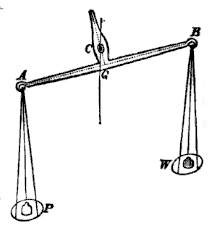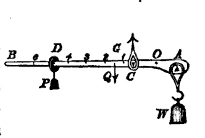Common Roman Steelyard
© Michael Haynes, https://www.mhaynesart.com. Used with permission.
Four or five plews (beaver skins) hang from a Roman steelyard. The counterweight has been moved to the point on the graduated scale at which the balance arm is nearly level. Their total weight may then be read from the scale shown on the balance arm.
The use of a lever as a tool for measuring weight in terms of current standards of weights and measures may be at least as old as labor and commerce. It embodies a classic proposition in elementary mechanics: If two weights balance each other on a straight lever in any position, they will balance in any other position of the lever.[1]S. Parkinson, An Elementary Treatise on Mechanics, 5th ed. (London: Macmillan, 1874), 113-15.
The lever weight-measuring machine, generically known simply as a balance, may have originated with the yoke used by men and women to carry burdens of similar size and weight, such as pails of milk or grain. Balances were used for measuring weights in Mesopotamia[2]“Weighing Instruments,” at http://catalogue.museogalileo.it/indepth/WeighingInstruments.html. Accessed 22 May 2016. Mesopotamia, where the first literate culture emerged during the fourth … Continue reading at least 4000 years before the Christian Era began. The word balance was used by the authors of several books of the Bible as a metaphor to represent the figurative values of various levels of good and evil.[3]See, for example, the story of Belshazzar’s feast in the Book of Daniel, 5:23-27, as translated in the original 1611 version of the King James version of the Bible, in which … Continue reading Beginning approximately two centuries B.C.E. the most accurate machine was the Roman balance, which during the fourteenth century A.D. acquired the name steelyard.
According to the Oxford English Dictionary, the noun steelyard was borrowed from the public place in London where merchants of the Hanseatic league or company could carry on their business in international commerce. In medieval Germany such a place had been called a stâlhof. At that time stâl meant sample or pattern; hof still means yard. Stâl was a homophone of Stahl, which is the German word for steel. In England, stâlhof was heard as Stahlhof, and was easily mistranslated as steelyard.
Lewis’s Scale and Steelyard
Common Balance

Parkinson, Elementary Treatise on Mechanics (1874).
Roman Steelyard

Parkinson, Elementary Treatise on Mechanics (1874).
Danish Steelyard

Parkinson, Elementary Treatise on Mechanics (1874).
This weighing device, which acquired a rather shady reputation, was first recorded in about 400 B.C.E., and was first known as a Bismar. It consisted of a wooden rod with a weight attached to one end, and near the other a hook from which was hung the goods to be weighed. The fulcrum, usually a hand-held loop of rope or wire, could be moved along the rod until equilibrium was attained. Unfortunately, it was notoriously inaccurate, which prompted Aristotle to condemn it as “an instrument of deceit,” possibly because it didn’t take a skilled craftsman, or an honest man, to contrive one.[4]J. T. Graham, Scales and Balances: A Guide to Collecting, 3rd ed. (Princes Risborough: Shire, 1993), 18. Like an international thief, it was known in different countries by different names. By the end of the 18th century it was known in England as a Danish steelyard. There is no evidence in the literature to suggest that Lewis and Clark stooped so low as to carry one of those.
Lewis’s shopping list included “a Pair large brass money scales with two setts of weights the one of Troy the other of Averds [avoirdupois].”[5]Jackson, Letters, 1:70. The “Recapitulation of Purchases by The Purveyor”—Israel Whelan of the Schuylkill Arsenal at Philadelphia—included “1 Set of Gold Scales & Wts.”[6]Ibid., 1:95. which may have been the same as “money scales.” They might have been as small as three and a quarter inches long, and possibly were of the same design as the common balance scale illustrated at right. On the tray marked P an object of known weight is placed as a counterbalance; to the opposite tray W material is added until the balance arm AB, suspended at the fulcrum C, is level. As we know, Lewis and Clark had neither any expectation nor interest in finding gold, but a small scale such as this would have been useful for measuring daily rations of flour, parched corn, or coffee. On 16 October 1804, Lewis used one to weigh a small bird he had captured (Phalaenoptilus nuttalli)—”1 oz 17 Grains Troy.”
Another purchase Whelan made for Lewis was “2 p[air?] Pocket Steelyards” from Harvy & Worth, merchants at 62 North Front Street, Philadelphia.[7]Ibid., 1:95. The classic pocket or spring steelyard, which was invented in England in 1760 by Richard Salter, simply consisted of a tempered steel helical spring encased in a tube that was closed at the upper end, and closed at the bottom except for a small centered hole. Some sort of handle, usually a ring or a hook, was affixed to the top of the tube, either to be held in hand or suspended from a stationary object. A solid rod slightly longer than the tube was suspended from a thin disk or piston that rested across the upper end of the spring, and passed freely through the hole in the tube’s bottom. Another ring or hook was attached to the rod’s lower end to hold the object to be weighed. A vertical flat plate was attached to the tube, and a slot was cut through both the plate and the tube from the point at which the piston was at rest with no weight on the rod, to the point at which the spring was fully compressed. A scale of measurements in half-pound increments was engraved on the plate adjacent to the slot. The weight of a given object then could be read by observing the level to which the spring had been compressed as indicated by the pointer.[8]The Penny Cyclopaedia of the Society for the Diffusion of Useful Knowledge (London: Charles Knight and Co., 1842), 385, s.v. “Spring-Balance.” Salter spring steelyards were later modified … Continue reading Pocket steelyards were made in various capacities, the smallest one—approximately nine inches long overall—accurately measuring up to 25 pounds. What capacities were covered by the two that Lewis purchased are not known.
A Roman steelyard determines the weight of an object by balancing an object of known mass with one of unknown weight. The balance lever hangs on a fulcrum near which is fastened a hook from which the article to be weighed is suspended. A counterbalance of known weight is moved along the longer arm until equilibrium is reached.
Although no larger steelyard is mentioned in the journals, there is ample evidence that Lewis and Clark carried something like a common Roman steelyard because they were able to weigh bundles, bags, barrels and boxes of supplies in order to facilitate orderly packing, and the efficient distribution of cargo within and among the boats. Also, they were able to record the weights of animals shot as scientific specimens. However, they were never able to weigh any of the grizzlies they shot. For example, on 5 May 1805, Lewis recorded that Clark and Drouillard had that day killed the largest bear they had yet seen. “We had no means of weighing this monster,” Lewis continued. “Capt. Clark thought he would weigh 500 lbs; for my own part I think the estimate to small by 100 lbs.” (In fact, grizzlies may weigh anywhere between 325 and 1500 pounds.)
Notes
| ↑1 | S. Parkinson, An Elementary Treatise on Mechanics, 5th ed. (London: Macmillan, 1874), 113-15. |
|---|---|
| ↑2 | “Weighing Instruments,” at http://catalogue.museogalileo.it/indepth/WeighingInstruments.html. Accessed 22 May 2016. Mesopotamia, where the first literate culture emerged during the fourth millenium B.C.E., was a region between the Tigris and Euphrates Rivers which included present-day Iraq, eastern Syria, southeastern Turkey, and southwestern Iran. |
| ↑3 | See, for example, the story of Belshazzar’s feast in the Book of Daniel, 5:23-27, as translated in the original 1611 version of the King James version of the Bible, in which “balance” is a metaphor for “judgment.” King Belshazzar of Babylon orders Daniel to interpret the mysterious handwriting on the wall: Mene, mene tekel upharsin. Daniel translates “tekel” as “thou art weighed in the balances, and art found wanting.” In the New American Bible (1970) it reads “you have been weighed on the scales and found wanting.” |
| ↑4 | J. T. Graham, Scales and Balances: A Guide to Collecting, 3rd ed. (Princes Risborough: Shire, 1993), 18. |
| ↑5 | Jackson, Letters, 1:70. |
| ↑6 | Ibid., 1:95. |
| ↑7 | Ibid., 1:95. |
| ↑8 | The Penny Cyclopaedia of the Society for the Diffusion of Useful Knowledge (London: Charles Knight and Co., 1842), 385, s.v. “Spring-Balance.” Salter spring steelyards were later modified to function as pressure valves for the early steam engines, including locomotives and steamboats. The Salter manufacturing company founded by Richard’s brother, George, was in business for nearly 200 years. Although descendants of the founding Salter family are no longer involved in it, the company still exists nominally, as Salter Online, and now makes a wide variety of digital scales for numerous uses. |
Experience the Lewis and Clark Trail
The Lewis and Clark Trail Experience—our sister site at lewisandclark.travel—connects the world to people and places on the Lewis and Clark Trail.
Discover More
- The Lewis and Clark Expedition: Day by Day by Gary E. Moulton (University of Nebraska Press, 2018). The story in prose, 14 May 1804–23 September 1806.
- The Lewis and Clark Journals: An American Epic of Discovery (abridged) by Gary E. Moulton (University of Nebraska Press, 2003). Selected journal excerpts, 14 May 1804–23 September 1806.
- The Lewis and Clark Journals. by Gary E. Moulton (University of Nebraska Press, 1983–2001). The complete story in 13 volumes.


